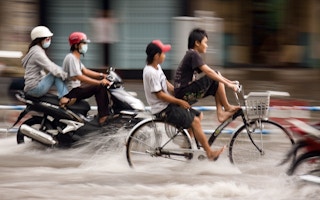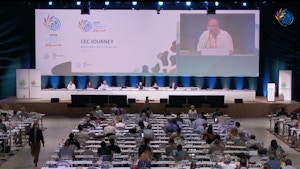Rich nations will need to boost efforts to provide funding for pandemic-hit poorer countries to battle climate change if they are to meet a promise of raising $100 billion a year from 2020, climate finance officials and analysts said on Friday.
In an annual update, the Organisation for Economic Co-operation and Development (OECD) said climate finance for developing states rose by 11 per cent to $78.9 billion in 2018 - about $20 billion short of a flagship goal set for this year.
In 2009, wealthy countries at UN climate talks agreed to channel $100 billion - from public and private sources - each year starting in 2020 to help poor nations develop in a low-carbon way and adapt to worsening climate change impacts.
But reaching that target has proved a challenge, even as demand for help is growing as a result of coronavirus-related economic downturns and surging climate-related disasters.
“Donors need to urgently step up their efforts to support developing countries to respond to the immediate effects of the pandemic and to integrate climate actions into each country’s recovery from the Covid-19 crisis,” OECD Secretary-General Angel Gurría said in a statement on the report.
Patriciah Roy Akullo, co-chair of the ACT Alliance’s climate justice group, said meeting the $100-billion goal was “about saving lives, and preventing further suffering around the world”, as wild weather intensifies and oceans creep higher.
“These funds are urgently needed to deliver action on the ground by people and communities in climate-vulnerable countries,” she said.
That could include planting drought-resistant seed varieties, providing early warning of storms, building higher flood defences, planting mangroves, or installing solar power.
Reaching the $100-billion-a-year target is seen as vital to the progress of UN climate negotiations.
Earlier this week, UN climate chief Patricia Espinosa told an investor forum the required resources “are simply not there yet” and urged them to encourage finance ministers to deliver.
“Timely provision of the $100 billion will help to build trust - it will also help provide important signals for investors,” she said.
But climate finance data is reported with a lag of up to two years, making it impossible to know whether the 2020 pledge will have been met by the end of this year.
Friday’s report showed that climate finance provided by wealthy governments increased to $62.2 billion in 2018, up from $54.5 billion in 2017, while the level of private climate finance mobilised was virtually flat at $14.6 billion.
Joe Thwaites, a climate finance expert at the World Resources Institute, said the rise in government funding was “reassuring”.
If that trend continued, it could push climate finance close to the $100-billion mark this year - but the pandemic was a threat, he said.
“Covid-19 has caused significant disruption in all kinds of finance flows in 2020, so I think it’s really hard to say,” he told the Thomson Reuters Foundation.
Debt burden
Aid groups expressed concern that the rate of growth in the climate finance total slowed in 2018 compared with 2017, and noted a sharp increase in loans that have to be paid back compared to grants that do not.
“Far too much of the climate finance from governments and development banks is in the form of loans that force poorer nations to fall further into debt as they struggle with the impacts of climate change,” said Tracy Carty, senior climate policy advisor at charity Oxfam.
The OECD report showed that between 2013 and 2018, the share of loans in government-provided climate finance grew from 52 per cent to 74 per cent, while the share of grants decreased from 27 per cent to 20 per cent.
Carty urged donors to start boosting grants, especially to help the most vulnerable countries adapt to more extreme weather and rising seas.
Oxfam also highlighted the small proportion of funding for the poorest and lowest-polluting countries, with just 14 per cent of climate finance going to the least-developed nations and 2 per cent to small island developing states, many facing high levels of debt.
Development experts pointed to the persistent imbalance between finance for countries to reduce their emissions by adopting clean, renewable energy and the far smaller amount spent on adapting to climate shifts.
In 2018, 70 per cent of total climate finance went toward emissions cuts, with only 21 per cent for adaptation, and the rest going to projects that supported both. But spending for adaptation grew by nearly 30 per cent per year from 2016 to 2018.
“There is a huge need for an increase in adaptation finance, and this is even more critical given the additional challenges that communities face due to Covid,” said Mattias Söderberg, co-chair of ACT’s climate justice group.
More for the poor
The heads of the multi-billion-dollar Green Climate Fund (GCF) and the International Development Finance Club (IDFC) said their organisations planned to step up efforts to boost private flows to tackle climate change “while leaving no one behind”.
GCF Executive Director Yannick Glemarec said on Friday that “blended” finance - where government money is used to make investments a safer bet for business - had so far not served the poorest and most vulnerable countries well.
“One of the key challenges we have… is to make climate finance work for the poor, to make blended finance work for adaptation and ecosystems,” he said.
When the GCF partners with national development banks or investors, it often allocates funding for the highest-risk part of a project, to encourage new business models, he added.
Both he and IDFC chairman Remy Rioux said the $100-billion goal was essential for the UN climate process, but far more money would be needed to effectively tackle global warming in developing countries, including building climate-safe infrastructure.
The IDFC, for example, said on Friday its members, a group of 26 national and regional development banks, had supplied $197 billion in green finance in 2019 - 95 per cent of it for climate-related projects - representing a quarter of their total lending.
“We have to think at a larger scale,” Rioux said.
This story was published with permission from Thomson Reuters Foundation, the charitable arm of Thomson Reuters, that covers humanitarian news, climate change, resilience, women’s rights, trafficking and property rights. Visit http://news.trust.org/climate.





















